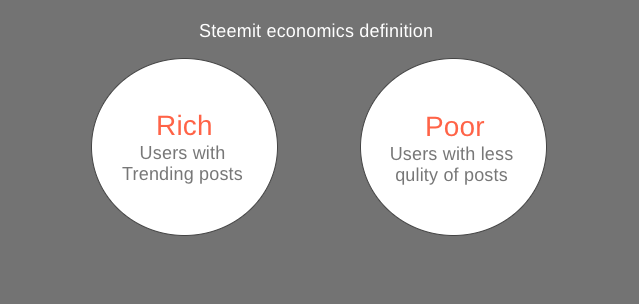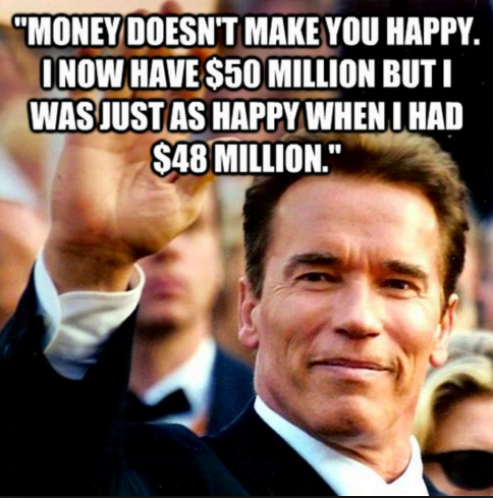Is Steem economically efficient? In depth look into the economics of Steemit!
I recently started educating myself about economy and I'm in no way an expert. However I'm trying to relate what I learn to Steem ecosystem and analyze how things are working here and how it could be in a better way. In the first article I am giving some introduction about the basics like efficiency and supply and demand and try to relate it to Steemit in a (hopefully) correct way. If you are also new to economics like me you might enjoy this article to catch up with some basics.
I need to mention that these definitions are not necessarily my opinion on this subject but how it is evaluated in today's economics.
What Is Efficiency?
The efficiency we mention in this article is actually Pareto Efficiency, which is used these days by most economists to consider if a policy is optimal or not. Pareto the economist behind this definition believes that an allocation of resources are efficient if we cannot reallocate it in a way that we can't make an individual better off without making another worse off.
This definition of efficiency is very unkind about humans as individuals and does not necessarily result to a socially desirable allocation of resources but to how the value for the whole community can be increased. If it leads to rich becoming more rich and poor becoming poorer everyday, it's still considered economically impeccable.

Economics of Steemit for Content Creators
For the sake of argument, let's just consider the economy for content makers instead of Steem as a whole. I may need to think and study more to consider how all these would work out in economic terms. So in this article let's just talk about content rewards and not mentioning anything about witnesses, early redistribution, comparison with FIAT and curation rewards.
The economics of Steem like most of the economics of today's world we live in is based on free markets. It means that instead of redistribution control or regulation policies the SP holders are free to give a price for any post in the platform and in the other hand contents created by content makers are evaluated on a market based pricing.
Definition of rich and poor
The main definition of rich in Steemit for most users are wales but in economic terms wales are just part of the supply of Steems and without them the Steem price wouldn't have any value so SP holders regardless of their value of SP (Steem Power) are all part of the distributed liquidity at this perspective. Of course fairness of early distribution is another interesting topic but is out of the scope of what I am trying to explain now.
So who is considered rich in this definition? Since the value each user is spending to create content for platform is only time and the quality of content they makes varies based on their talent, knowledge, experience and many other factors, rich people are the users who are more popular and easily get into the trending list. Since the reward pool for STEEM is limited, like any other supply and demand in a free market the rich would get the best resources (more STEEMs) since their skills are demanded by SP holders.

Supply and Demand
To understand the economics for content makers, let's first understand what is supply and demand and how we can relate it to this market. Basically supply and demand is defined when there is a limited commodity available and there are consumers that are competing by putting different values for it. In case of Steemit, the supply is the reward pool which is limited in quantity and demand is the content. Content creators are willing to spend time for making content to enter the competition and earn a bigger percentage of reward pool.

In an efficient market, the cost of production for anything should not surpass the amount consumers are willing to pay for it. In our example Steem's economy shouldn't reward any Steem to a post that worth less than its value in the market.
The reward pool for content creators in Steem is something around 36000 Steem per day with current rates (correct me if I'm wrong) but for the sake of simplicity let's consider the daily reward pool is only 100 Steem and that's all SP holders can allocate as resources.
Content maker A is a professional travel blogger and can be hired anytime outside of Steemit platform to make contents. Let's say she is creating a content that is valued equal to 50 STEEM in the market. If SP holders reward her with anything below 50 STEEM she will theoretically leave the platform for a better alternative. If they reward her with more than 50 STEEM she is happy and if they reward her with exactly 50 STEEM, she is indifferent about posting on Steemit or anywhere else.
How much a content is valued in market is important since we can understand how much the amount of STEEM content makers get rewarded are worth for them. If content maker A is rewarded 70 STEEM for example, the reward worth 20 STEEM for her and she is willing to invest more of her time in the platform.
Is It Economically Efficient If We Give The Rich More STEEM?

Yes and no! In the last example we observed that content creator A is getting rewarded 20 STEEM more than her worth of production. However, since the reward pool is limited and will be allocated to users anyway if Steemit cannot attract the best content creators in the market the mentioned surplus will keep increasing. Because simply all the good content creators will leave the platform and bad content creators will get exactly the same share of reward pool for content that is worth less than what content maker A produced. For example if content maker A is not willing to post anymore, content maker B may write a post worth 10 STEEM and get a surplus of 60 STEEM.
Having said so, with current fixed rewards pool, the best way to avoid paying more for a content is to pay higher reward to the best authors to attract more users and raise the competition until the rewards for trending posts always is equal or less than how much they are worth for the platform. It is economically efficient to pay more for those contents to grow the platform but it is not the case for poor or users that are not able to make high quality content or get them noticed by the community.
In a Pareto efficient economy, we cannot afford to pay more to users with lower quality of content because it will attract more of those users and the saying is that it is not economically efficient because the poor is eating too much!
How a More Equal re-distribution is Not Efficient
To put it into perspective, let's imagine Steem blockchain would hardfork into a version that would redistribute 20% of reward pool to every valid post in the platform (let's imagine we could figure out a way to omit spam attacks).
Now that the reward pool is losing 10 STEEM, content maker A is going to make 60 STEEM which is still 10 STEEM of surplus for her. But based on Pareto Efficiency we made a change which made one party worse off. In a Utilitarianism view this is acceptable because the utility of a basic income for minnows is much more than the utility of Steem for richer users. Imagine how much one STEEM brings utility to a minnow compared to a Wale or dolphin. But in Pareto efficiency which shapes our world's today economy we should only think about the value of utility for the whole group of people and we are not allowed to judge how much one unit of money worth to each person. What if the rich would like to see the poor stays poor and would hurt by losing his influence?
Conclusion
I wrote this article to review my learnings about these concepts in Steem terms. I need to mention again that these definitions are how things are defined in free market and is not necessarily the best way to re-distribute resources. However, considering all these opinionated examples I can conclude that Steem's blockchain is efficient as a whole as long as the number of content makers are high enough to avoid dedication of the majority of reward pool to the best "available" post rather than the best worthy post.
In the next articles I would like to write about more ethical theories like Utilitarianism and compare it to how they may result in a happier community in the end.
Image 1: Source
Thank you for this informative and interesting post. It was a very thoughtful analysis. What bothers me is that if there is an inefficiency in the economic system of steem, is there a mechanism to improve it or is it a rigid system without the possibility of change?
Thank you very much for reading. I don't believe in-efficiency in an economical term is necessarily a bad thing. After all most of the economic decisions in countries like US are economically efficient and that's why they don't have a proper healthcare yet. Even so, to answer your question technically Steem blockchain is not rigid at all and is one of the easiest blockchains in the market to make changes since the number of witnesses are very small compared to other chains and they usually agree with Steemit inc. Any hard-fork you heard about until now is a change in the governance and mechanism of blockchain.
Thank you for your reply.
Very interesting approach :) tip!
Thank you for reading and tip :-) I'm trying to help myself understand economic terms better with these articles. Feel free to re-esteem if you think it helps.
Very interesting analysis. Good work!!
Thanks!
@p0o got you a $1.78 @minnowbooster upgoat, nice! (Image: pixabay.com)
Want a boost? Click here to read more!
Steemit economy, poor and rich. The rich will continue to be rich and the poor will get poorer 👍
Follow upvote and resteem @p0o
In Steem, the poorest have the chance to get rich. All they need is $10 starting amount, get posting, buy 10 randowhale votes, and use the increased rewards on new posts. After a week you have $100. After a year you have $5,000.
Yes, thanks information my friend @ericwoelk 😊
Now go and do it :D
Thats true even if you dont use randowhale you can. Did 100 in 3 weeks without any randowhale or bot at the begining just by posting and comenting.
True. It's just a wasted option not to use randowhale on your posts.
This post is not aiming to have any pessimistic judgment about the wealthy community of Steemit since I believe there is nothing wrong with them. It's more about understanding how it works rather than blindly envision it as the ultimate solution to economical freedom which is not what Steem is made to be.
@tipU - send tips by writing tip! in the comment and get share in service profit :)
Check out @promoted - the good guy voting bot.